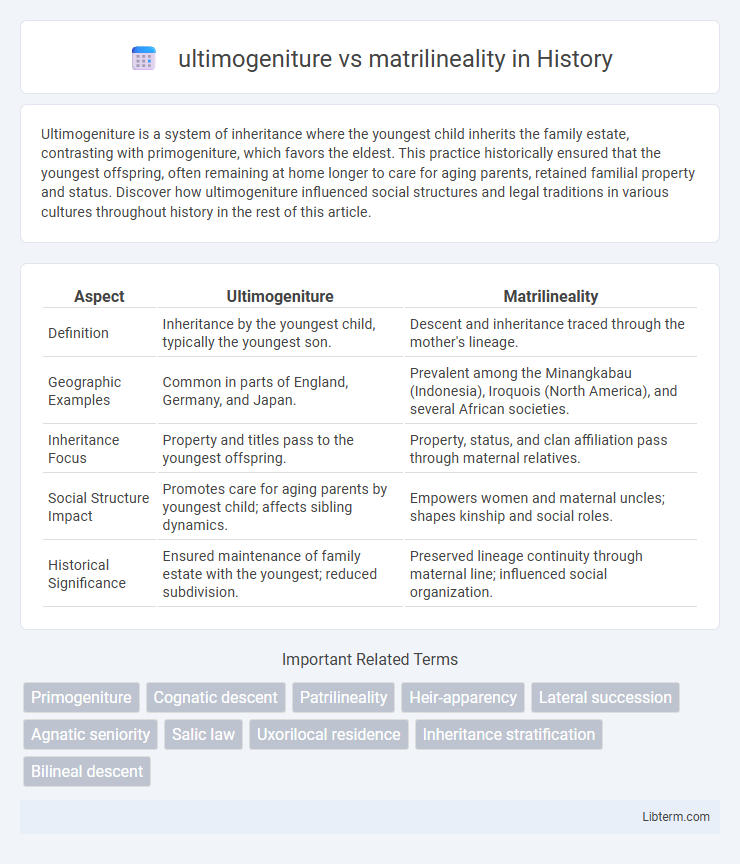Ultimogeniture is a system of inheritance where the youngest child inherits the family estate, contrasting with primogeniture, which favors the eldest. This practice historically ensured that the youngest offspring, often remaining at home longer to care for aging parents, retained familial property and status. Discover how ultimogeniture influenced social structures and legal traditions in various cultures throughout history in the rest of this article.
Table of Comparison
| Aspect | Ultimogeniture | Matrilineality |
|---|---|---|
| Definition | Inheritance by the youngest child, typically the youngest son. | Descent and inheritance traced through the mother's lineage. |
| Geographic Examples | Common in parts of England, Germany, and Japan. | Prevalent among the Minangkabau (Indonesia), Iroquois (North America), and several African societies. |
| Inheritance Focus | Property and titles pass to the youngest offspring. | Property, status, and clan affiliation pass through maternal relatives. |
| Social Structure Impact | Promotes care for aging parents by youngest child; affects sibling dynamics. | Empowers women and maternal uncles; shapes kinship and social roles. |
| Historical Significance | Ensured maintenance of family estate with the youngest; reduced subdivision. | Preserved lineage continuity through maternal line; influenced social organization. |
Understanding Ultimogeniture: Definition and Historical Context
Ultimogeniture is a system of inheritance where the youngest child inherits the family estate, contrasting with primogeniture which favors the eldest. Historically, ultimogeniture has been practiced in various cultures, including some European and Asian societies, often linked to keeping property within the immediate household or ensuring care for aging parents. Matrilineality, by comparison, traces descent and inheritance through the mother's lineage, emphasizing female kinship lines and often influencing social structure and property rights differently than ultimogeniture.
Matrilineality Explained: Tracing Descent Through the Mother
Matrilineality is a system of kinship where descent, inheritance, and lineage are traced through the mother's line rather than the father's, emphasizing the maternal connection in family structure. This contrasts with ultimogeniture, a inheritance practice granting the youngest child, often the last-born son, exclusive rights to property or family assets. Understanding matrilineality reveals its cultural significance in societies that prioritize maternal ancestry for identity, inheritance, and social status, highlighting the differences in how lineage and property rights are organized.
Key Differences Between Ultimogeniture and Matrilineality
Ultimogeniture is a system of inheritance where the youngest child inherits property or titles, whereas matrilineality traces descent and inheritance through the mother's lineage. Ultimogeniture emphasizes birth order regardless of gender, often favoring the last-born son, while matrilineality prioritizes maternal ancestry and the transmission of wealth or status through female relatives. These key differences highlight distinct cultural approaches to lineage and inheritance rights within societies.
Inheritance Patterns: Contrasts and Implications
Ultimogeniture, where the youngest child inherits the estate, contrasts sharply with matrilineality, which dictates inheritance through the mother's lineage. Ultimogeniture often concentrates property and wealth in the hands of the last-born son, impacting family dynamics by preserving land within a direct descending line. Matrilineal inheritance shifts property and social status through female ancestors, influencing kinship ties, resource distribution, and cultural identity across generations.
Cultural Examples of Ultimogeniture Worldwide
Ultimogeniture, the inheritance system where the youngest child inherits the family estate, is practiced in diverse cultures such as the Maasai of East Africa, the Nairs of Kerala in India, and certain rural English communities. This system contrasts sharply with matrilineality, where lineage and inheritance pass through the female line, as seen in the Minangkabau of Indonesia and the Akan of Ghana. Cultural contexts shape these inheritance practices, reflecting local social structures, gender roles, and familial priorities unique to each society.
Societies Practicing Matrilineality: Notable Cases
Societies practicing matrilineality, such as the Minangkabau of Indonesia and the Mosuo of China, trace descent and inheritance through the female line, impacting social organization and property rights. Ultimogeniture, the inheritance by the youngest child, contrasts sharply with these systems, as it prioritizes birth order rather than gender or lineage for property succession. Notable matrilineal cultures emphasize female-centered clan membership, influencing residence patterns and leadership roles within their communities.
Gender Roles in Ultimogeniture and Matrilineal Systems
Gender roles in ultimogeniture systems often emphasize patriarchal inheritance, where the youngest son inherits family property, reinforcing male authority and continuity. In contrast, matrilineality centers inheritance and descent through the female line, granting women significant influence in lineage, property, and social status. These differing frameworks shape family dynamics, with ultimogeniture prioritizing male heirs and matrilineality elevating women's roles in kinship and resource control.
Social and Economic Impacts of Each System
Ultimogeniture, where the youngest child inherits property, often preserves family wealth within traditional patriarchal structures, potentially limiting social mobility but ensuring economic stability for the youngest generation. Matrilineality, tracing descent and inheritance through the female line, can strengthen social cohesion among women and provide economic security for daughters, influencing land ownership and resource control patterns. Both systems significantly shape family dynamics, gender roles, and access to economic resources, affecting societal organization and wealth distribution in distinct cultural contexts.
Modern Relevance and Contemporary Shifts
Ultimogeniture and matrilineality exhibit distinct patterns in inheritance and lineage, with ultimogeniture favoring the youngest child and matrilineality tracing descent through the female line. Contemporary shifts reveal a growing interest in matrilineal systems as societies reevaluate gender roles, property rights, and cultural heritage preservation. Modern relevance is highlighted by the resurgence of matrilineal inheritance in indigenous communities and legal reforms challenging traditional ultimogeniture practices in favor of gender-equitable frameworks.
Future Perspectives: Evolving Family Structures and Inheritance
Ultimogeniture, favoring the youngest child in inheritance, contrasts with matrilineality, where lineage and property pass through the female line, reflecting diverse cultural approaches to family structure. Future perspectives indicate increasing hybridity and adaptation as globalization and shifting gender norms influence inheritance laws and family arrangements. Emerging trends emphasize equitable wealth distribution and recognition of non-traditional heirs, reshaping traditional ultimatogeniture and matrilineal frameworks to accommodate evolving social dynamics.
ultimogeniture Infographic

 libterm.com
libterm.com